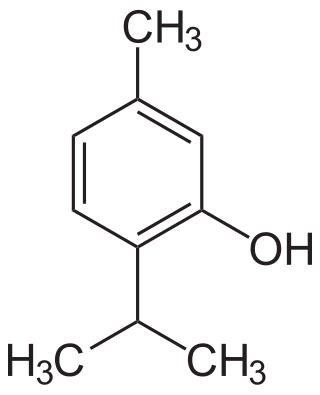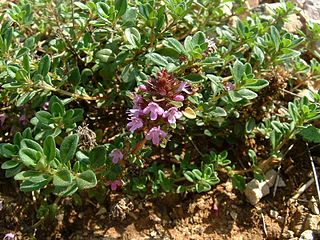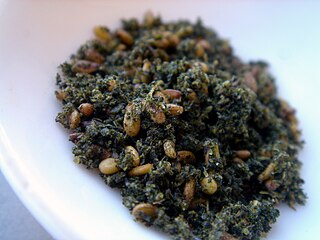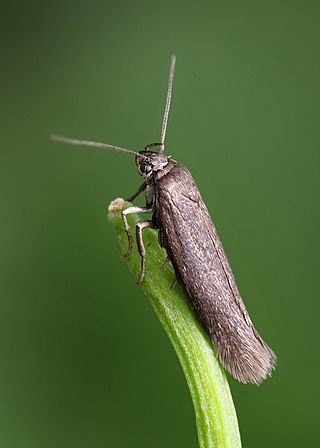Thyme is any member of the genus Thymus of aromatic herbs with culinary, medicinal, and ornamental uses.
Contents
Thyme may also refer to:
Thyme is any member of the genus Thymus of aromatic herbs with culinary, medicinal, and ornamental uses.
Thyme may also refer to:

Thyme is a culinary herb consisting of the dried aerial parts of some members of the genus Thymus of flowering plants in the mint family Lamiaceae. Thymes are native to Eurasia and north Africa. Thymes have culinary, medicinal, and ornamental uses. The species most commonly cultivated and used for culinary purposes is Thymus vulgaris, native to Southeast Europe.

The thymus is a specialized primary lymphoid organ of the immune system. Within the thymus, thymus cell lymphocytes or T cells mature. T cells are critical to the adaptive immune system, where the body adapts to specific foreign invaders. The thymus is located in the upper front part of the chest, in the anterior superior mediastinum, behind the sternum, and in front of the heart. It is made up of two lobes, each consisting of a central medulla and an outer cortex, surrounded by a capsule.

Thymol, C10H14O, is a natural monoterpenoid phenol derivative of p-Cymene, isomeric with carvacrol, found in oil of thyme, and extracted from Thymus vulgaris, ajwain, and various other plants as a white crystalline substance of a pleasant aromatic odor and strong antiseptic properties. Thymol also provides the distinctive, strong flavor of the culinary herb thyme, also produced from T. vulgaris. Thymol is only slightly soluble in water at neutral pH, but it is extremely soluble in alcohols and other organic solvents. It is also soluble in strongly alkaline aqueous solutions due to deprotonation of the phenol. Its dissociation constant (pKa) is 10.59±0.10. Thymol absorbs maximum UV radiation at 274 nm.

The genus Thymus contains about 350 species of aromatic perennial herbaceous plants and subshrubs up to 40 cm tall in the family Lamiaceae, native to temperate regions in Europe, North Africa and Asia. Thymus species are particularly concentrated in Iran, attributed to Iran's diverse climate and topographic/geographic location.

Thymus serpyllum, known by the common names of Breckland thyme, Breckland wild thyme, wild thyme, creeping thyme, or elfin thyme, is a species of flowering plant in the mint family Lamiaceae, native to most of Europe and North Africa. It is a low, usually prostrate subshrub growing to 2 cm (1 in) tall with creeping stems up to 10 cm (4 in) long. The oval evergreen leaves are 3–8 mm long. The strongly scented flowers are either lilac, pink-purple, magenta, or a rare white, all 4–6 mm long and produced in clusters. The hardy plant tolerates some pedestrian traffic and produces odors ranging from heavily herbal to lightly lemon, depending on the variety.

Za'atar is a Levantine culinary herb or family of herbs. It is also the name of a spice mixture that includes the herb along with toasted sesame seeds, dried sumac, often salt, and other spices. As a family of related Levantine herbs, it contains plants from the genera Origanum (oregano), Calamintha, Thymus, and Satureja (savory) plants. The name za'atar alone most properly applies to Origanum syriacum, considered in biblical scholarship to be the ezov of the Hebrew Bible, often translated as hyssop but distinct from modern Hyssopus officinalis.
Oregano is an herb commonly used in cooking.

Thymus praecox is a species of thyme. A common name is mother of thyme, but "creeping thyme" and "wild thyme" may be used where Thymus serpyllum, which also shares these names, is not found. It is native to central, southern, and western Europe.

Thymus herba-barona is a species of thyme native to Corsica, Sardinia, and Majorca. It is also sometimes known by the common name caraway thyme, as it has a strong scent similar to caraway, for which it can be used as a substitute in any recipe. It can be used in cuisine or as an evergreen ground cover plant for the garden.

Thymus vulgaris is a species of flowering plant in the mint family Lamiaceae, native to southern Europe from the western Mediterranean to southern Italy. Growing to 15–30 cm (6–12 in) tall by 40 cm (16 in) wide, it is a bushy, woody-based evergreen subshrub with small, highly aromatic, grey-green leaves and clusters of purple or pink flowers in early summer.

Thymus citriodorus, the lemon thyme or citrus thyme, is a lemon-scented evergreen mat-forming perennial plant in the family Lamiaceae. There has been a great amount of confusion over the plant's correct name and origin. Recent DNA analysis suggests that it is not a hybrid or cross, but a distinct species as it was first described in 1811., yet an analysis in a different study clustered Thymus citriodorus together with Thymus vulgaris, which is considered as one of its parent species.
Thymus hyperplasia refers to an enlargement ("hyperplasia") of the thymus.
Timus may refer to:
Thymic involution is the shrinking (involution) of the thymus with age, resulting in changes in the architecture of the thymus and a decrease in tissue mass. Thymus involution is one of the major characteristics of vertebrate immunology, and occurs in almost all vertebrates, from birds, teleosts, amphibians to reptiles, though the thymi of a few species of sharks are known not to involute. This process is genetically regulated, with the nucleic material responsible being an example of a conserved sequence — one maintained through natural selection since it arose in a common ancestor of all species now exhibiting it, via a phenomenon known to bioinformaticists as an orthologic sequence homology.
Thymus montanus may refer to one of following Lamiaceae species:

Van herbed cheese is a type of cheese traditionally made from raw sheep milk, though cow and goat milk may be used or added. It is semi-hard in texture, and is produced primarily in the Van Province of Turkey.
T. camphoratus can refer to a few different species. The specific epithet camphoratus refers to 'camphor.'

Thymus zygis is a type of flowering plant in the family Lamiaceae native to the Iberian Peninsula and northern Morocco.

Scythris picaepennis is a moth of the family Scythrididae first described by Adrian Hardy Haworth in 1828. It is found in Europe.